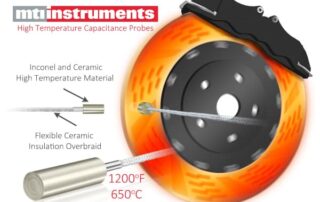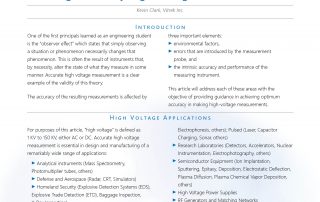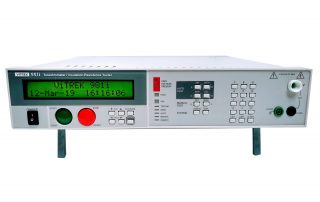Blogs
Measuring Brake Rotor Thickness Variation with Capacitive Sensing
Brake rotor thickness variation, or disc thickness variation (DTV), causes uneven wear to brake rotors, disc-shaped automotive parts that are squeezed between brake pads to slow or stop a vehicle’s wheels. When a brake rotor has areas of different thickness, the amount of clamping force that’s applied across the rotor’s surface varies. These differences in clamping force lead to difference in torque, and the results may include brake shuddering, pulsating, or vibration. Even under normal driving conditions, brake rotors are subjected to extreme conditions that can cause performance-related issues. To ensure that brake rotors can perform properly without problems such [...]
White Paper: High Accuracy, High Voltage Measurement – April, 2019
Introduction One of the first principals learned as an engineering student is the “observer effect” which states that simply observing a situation or phenomenon necessarily changes that phenomenon. This is often the result of instruments that, by necessity, alter the state of what they measure in some manner. Accurate high-voltage measurement is a clear example of the validity of this theory. The accuracy of the resulting measurements is affected by three important elements: environmental factors, errors that are introduced by the measurement probe, and the intrinsic accuracy and performance of the measuring instrument. This article will address each of [...]
New Product Release: Vitrek’s 98i Series Teraohmmeter Meets Demands for Higher Voltage IR Testing
New Product Release: Vitrek’s 98xi Series Teraohmmeter Meets Demands for Higher Voltage IR Testing Meets requirements for emerging higher voltage electric vehicle battery system and solar array insulation resistance testing; offers unique combination of operational features; capacitive load capability facilitates solar system and cable harness testing […]
Aircraft Engine Test Cell is World’s Largest
The world’s largest aircraft engine test cell is in Atlanta, Georgia (USA), home of the upcoming MRO Americas 2019 show for the commercial air-transport maintenance, repair and overhaul (MRO) industry. Delta TechOps, a division of Delta Airlines and a full-service MRO, recently opened a $100 million test cell at its Atlanta facility that’s capable of running a jet engine at 150,000 lb. thrust. That’s more thrust than the GE Aviation GE90 engine, which powers Delta’s Boeing 777-200 LR fleet, can produce. “This test cell is a vote of confidence in Delta TechOps,” said Ed Bastian, Delta Airlines CEO, in [...]
Proforma 300i SA Video Shows Semiconductor Metrology
MTI Instruments, a worldwide leader in precision measurement solutions, has released a YouTube video that shows how its Proforma™ 300i SA semi-automated measurement tool measures silicon carbide wafers for semiconductors. George Relan, MTI’s Global Director of Sales, demonstrates how the desktop metrology system provides non-contact full wafer scanning and 3D mapping of measurement features such as thickness and shape. MTI’s video also shows how the Proforma 300i SA interfaces with an external computer and provides powerful Windows-based software for analysis and reporting. By utilizing MTI push/pull technology, the Proforma 300i SA doesn’t require the semiconductor wafers to have a [...]
MRO Americas 2019: Engine Vibration Analysis from MTI Instruments (Booth #2301)
MTI Instruments, a U.S.-based manufacturer of engine vibration analysis and balancing systems, will exhibit at MRO Americas 2019 from April 9 to 11 at the Georgia World Congress Center in Atlanta, Georgia (USA). Visit MTI Instruments in Booth #2301 at MRO Americas, the premiere event for the commercial air-transport maintenance, repair and overhaul (MRO) industry, to see its PBS-4100 line of vibration and balancing systems. MTI instruments will also give away a 1501A precision signal/function generator. Aircraft engine vibrations caused by out-of-balance parts can lead to cracked fan, turbine, and compressor components. Imbalance-induced vibrations can also cause metal fatigue [...]
Vitrek Names Bob D’Amico as New Eastern Regional Sales Manager
Vitrek Names Bob D’Amico as New Eastern Regional Sales Manager Industry professional brings two decades of direct industry expertise to support company’s growth in high voltage test and measurement products and systems […]
Navy Orders Avionics Test and Measurement Systems
The U.S. Navy wants new avionics test and measurement systems. Under the terms of a $109-million award, the Naval Air Warfare Center Aircraft Division in Lakehurst, New Jersey will buy 41 electronic consolidated automated support systems (eCASS) from Lockheed Martin. This test and measurement equipment helps soldiers and Marines troubleshoot and repair aviation electronics while at sea. Avionics, the electronics used in aircraft, support essential navigation and communications functions. With military aircraft, avionics typically include electro-optical, infrared, and other types of sensors for airborne radar, weapons systems, and heads-up displays. Military avionics also need to support electronic warfare systems, [...]
Fiber Optic Sensors Help Stop Subway Shutdown
Fiber optic sensors will help keep commuters moving between Manhattan and Brooklyn this year and beyond. Recently, New York Governor Andrew Cuomo announced that New York City’s Metropolitan Transit Authority (MTA) would not close the L train tunnel for a planned 15-month repair project. Instead, the MTA will use technology-driven solutions to keep the tunnel open and operational for weekday riders. In a joint statement, a panel that included engineering experts from Columbia and Cornell explained that "The L Train Tunnel project gives us the opportunity to integrate technologies and methods that have never been used before in a [...]
3D Integrated Circuits Use Capacitive Sensing to Ensure Coplanarity
Three-dimensional (3D) integrated circuits (ICs) feature silicon wafers and dies that are stacked vertically for improved device performance. By using the Z-axis, 3D ICs can overcome the power and footprint limitations associated with two-dimensional (2D) integrated circuits. Yet 3D ICs need coplanar surfaces to contact all of the pads, pins, and pillars. To determine coplanarity, semiconductor manufacturers measure the angle and gap between two planes. Bonding tool actuators use these measurements to adjust components and ensure that all device pins and solder balls reside on the same geometric plane. This process, active parallelism compensation, promotes proper bonding without residual [...]









